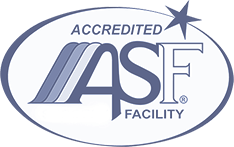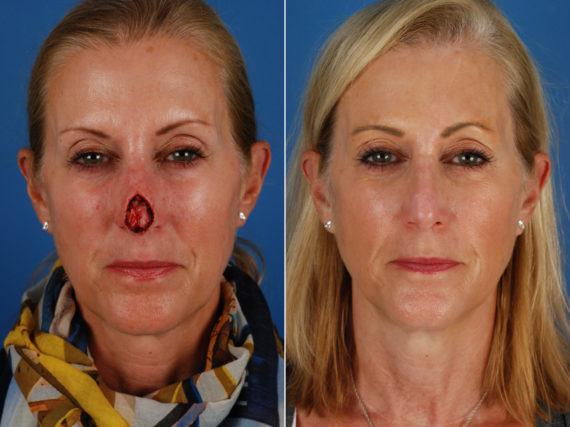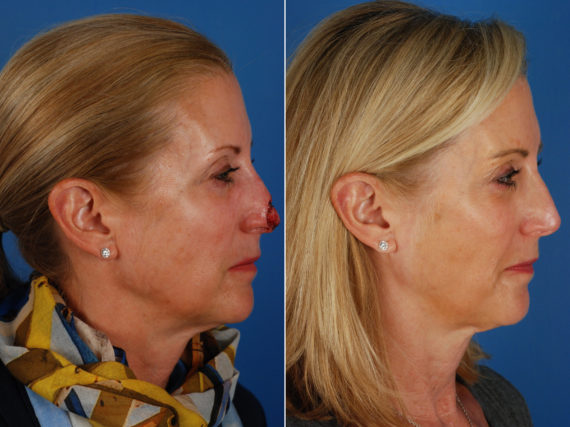Skin Cancer Reconstruction Benefits for a Fresh Start
Skin Cancer Reconstruction is more than a medical procedure; it’s a journey towards restoring your skin’s health and appearance. This specialized treatment focuses on healing and rejuvenating areas affected by skin cancer, offering a blend of medical expertise and aesthetic care. By choosing Skin Cancer Reconstruction, you embark on a path to recovery, confidence, and renewal.
Our Achievements
What is Mohs Reconstruction?
When it comes to cosmetically-delicate areas, the face and neck are especially sensitive. There are also areas of the body that are just as vulnerable. Unfortunately, due to repeated sun exposure, there are parts of the face like the ears, nose, eyelids, and lips that are especially prone to the development of skin cancer.
The Mohs surgical procedure is currently the most effective way to treat the most common types of skin cancers, such as basal cell carcinomas, or BCCs, and squamous cell carcinomas, or SCCs.
Mohs technique performed by dermatologists ensures the removal of a carcinoma with the highest cure rate while sparing healthy cells. Because the defects that are created are the smallest possible to effectively remove the cancer, scars are minimized with the procedure.
The procedure has a few stages, the last of which is Mohs reconstruction. This is when a plastic surgeon may become involved in your care to close your complex wound. This process is done with extreme care and aptitude. Many times, though all surgeries leave scars, you would be hard-pressed to find them if you did not know they were there.

Skin Cancer Reconstruction Good Candidates
Your dermatologist will decide if you are a candidate for Mohs surgery. The treatment is gentle enough to remove a carcinoma from a sensitive functional or cosmetic spot like the toes, fingers, scalp, eyelids, ears, lips, genitals, or nose. However, it is effective enough to combat an aggressive carcinoma over a large area that may be massive and indistinct. The procedure can even treat a carcinoma that has recurred after past skin cancer treatments have failed.
If you are planning to undergo Mohs surgery by a Mohs trained dermatologist, your dermatologist may call upon one of our board-certified surgeons (Dr. Holmes or Dr. Agarwal) to assist with closing a complex defect. Our surgeons do not perform Mohs surgery to remove skin cancers.
Why Choose Skin Cancer Reconstruction?
There are many reasons to choose Mohs surgery. Here are just a few of the best justifications for considering it:
- It is an outpatient procedure
- Only requires local anesthesia
- All lab work is completed on-site
- Your doctor examines 100% of your tumor margins, giving accurate results
- The process spares healthy cells, leaving the smallest wound possible
- An effective treatment option that is not overly expensive
- Boasts the highest rates of cure, at 97-99% for new tumors and 90-94% for those that were previously treated
CALL TODAY TO SCHEDULE YOUR CONSULTATION
The Skin Cancer Reconstruction Consultation at our Naples Office
Proper Mohs surgery is administered by physicians adept at three different roles. These are:
- the surgeon that removes the cancerous cells (a Mohs surgeon is a dermatologist generally with advanced training in Mohs surgery)
- potentially a pathologist that takes a look at the tissue in the lab
- the plastic surgeon that closes the wound meticulously with skin cancer reconstruction techniques
Board-certified surgeons like Dr. Holmes and Dr. Agarwal are extraordinarily experienced at skin cancer reconstruction so Mohs scars will heal in as attractive a manner as possible. Dermatologists in our area achieve the highest cure rates through Mohs surgery. Afterward, they simply dress the wound and send patients to our office within a few days, to repair the area via Mohs reconstruction, so the wound will heal with the least scarring possible.

Skin Cancer Before & After Photos
* Each patient is unique and individual results may vary.
The Mohs Reconstruction Process
Skin cancer reconstruction is a reconstructive surgical technique used to address the physical and aesthetic consequences of skin cancer surgery. Skin cancers, such as squamous cell carcinoma, basal cell carcinoma, and melanoma, are among the most common forms of malignancy in humans and can be treated with Mohs micrographic surgery or other surgical techniques. Mohs micrographic surgery involves the removal of a layer of tissue at a time, until all cancer cells are removed and healthy tissue remains. Reconstruction following skin cancer treatment requires an understanding of wound healing principles as well as cosmetic facial plastic surgical techniques to achieve the best possible outcome.
The entire procedure begins with a thorough evaluation by a dermatologic surgeon or facial plastic surgeon who will review medical history, perform an examination of the affected area, and determine which type of skin cancer is present. This is followed by surgical excision with precise margins to remove all skin lesions without damaging nearby healthy skin. The size of the wound dictates what type of reconstruction after skin cancer will be used: primary closure (stitching together healthy edges) for small wounds or larger wounds may require either a skin graft or flap reconstruction depending on the amount of laxity in the surrounding tissue and patient’s goals.
This requires knowledge not just in advanced wound healing principles but also knowledge in facial anatomy so that scars are minimized and cosmetically appealing outcomes can be achieved. Common techniques include local flaps (relocating neighborhood tissues), regional flaps (moving more distant tissues), free flaps (harvesting distant flap from another body part), advancement flaps (pulling adjacent tissues together) or combinations thereof depending on what’s needed to properly close larger wounds with significant underlying irregularities in contour due to previous scarring from prior treatments for skin cancer.
The success rate for Mohs reconstruction depends on many factors such as skill level & experience level within both disciplines – dermatology & facial plastic surgery – but also upon patient-specific factors such as age, location & size/type of lesion being treated as well as any underlying health issues that could potentially impede healing process postoperatively. Clinical trials continue to report positive results when combining Mohs micrographic surgery & reconstructive surgery for accurate tumor removal & excellent cosmetic outcomes respectively.
Skin Cancer Reconstruction Recovery
It is crucial that you follow our directions when it comes to wound care. Remember, recovery and healing time are completely dependent on the type and scope of your Mohs reconstruction.
You may experience some tenderness or soreness post-surgery. Tylenol, however, should be strong enough to handle the discomfort. If you find that you may need a stronger pain reliever, our Naples plastic surgeons will most likely prescribe one for you. Bruising and swelling may also develop close to your wound. This is especially true if the surgery was performed close to the eyes. Proper rest should quell the likelihood of this possibility.
You should limit physical activity that is likely to raise your heart rate for at least one week after Mohs surgery. Also, try not to stoop or bend over if possible. Traveling right away is also discouraged, so if you came from far away to have the surgery, make plans to stay at a nearby hotel for a few days.
Facial stitches are usually removed within a week and stitches on other parts of the body are usually removed sometime within the first two weeks. While the incisions may look bumpy and pink at first, they will dramatically improve with time as the scars go through the normal maturation process over the first year. The redness and raised nature of the wound will improve up to a year after Mohs reconstruction.
Why choose Aesthetic Surgery Center
Dr. Anurag Agarwal, M.D., F.A.C.S.
- Double board-certified facial plastic surgeon by the American Board of Facial Plastic and Reconstructive Surgery and the American Board of Otolaryngology – Head and Neck Surgery.
- Oral examiner and Board of Directors for the American Board of Facial Plastic and Reconstructive Surgery
- Former President of the Florida Society of Facial Plastic and Reconstructive Surgery
- Received his Doctor of Medicine at Philadelphia’s MCP-Hahnemann School of Medicine in 1999 and was elected to the Alpha Omega Alpha Honor Society.
- In 2016, Dr. Agarwal was honored at the annual American Academy of Facial Plastic and Reconstructive Surgery national meeting.
- Board-certified plastic surgeon by the American Board of Plastic Surgery.
- Attended medical school at UNMC (University of Nebraska Medical College).
- Was elected to the Alpha Omega Alpha Honor Society.
- Member of The Aesthetic Society, the Florida Medical Association, and Collier County Medical Society.
- General surgery residency at Loyola University Medical Center in Maywood, IL
- Plastic surgery residency at Cleveland Clinic Florida











